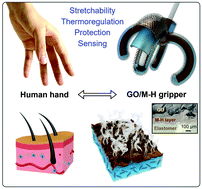2D-Material-integrated hydrogels as multifunctional protective skins for soft robots†
Abstract
Soft robots provide compliant object–machine interactions, but they exhibit insufficient material stability, which restricts them from working in harsh environments. Herein, we developed a class of soft robotic skins based on two-dimensional materials (2DMs) and gelatin hydrogels, featuring skin-like multifunctionality (stretchability, thermoregulation, threat protection, and strain sensing). The 2DM-integrated hydrogel (2DM/H) skins enabled soft robots to execute designated missions in the presence of high levels of heat and various environmental threats while maintaining mild machine temperatures. Via adopting different 2DMs (graphene oxide (GO), montmorillonite (MMT), and titanium carbide (MXene)), the 2DM/H-protected robots were able to perform soft grasping in organic liquids (GO/H) and open fire (MMT/H), and in the presence of electromagnetic radiation and biocontamination (MXene/H). Through blending MXene nanosheets into gelatin, the MXene-blended hydrogel (M–H) skin became strain sensitive, and a GO/M–H gripper exhibited the high-level integration of skin-mimicking capabilities. Finally, we incorporated 2DM/H skins onto an origami-inspired walker robot and a soft batoid-like robot to execute vision-guided searching in fire and underwater locomotion/navigation in chemical spills.



 Please wait while we load your content...
Please wait while we load your content...